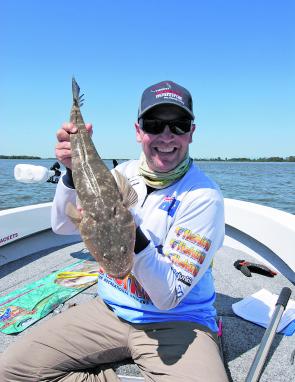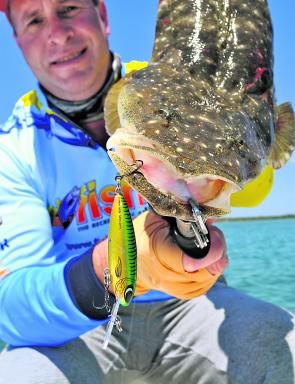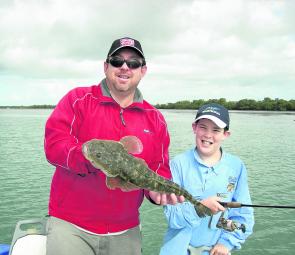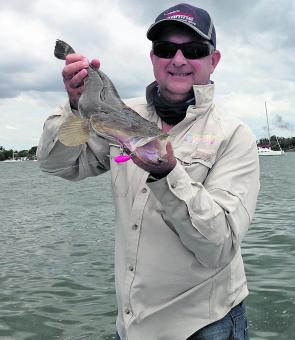I’ve been getting right into trolling for flathead in shallow water lately and it’s something that is really appealing. Punting along nice and quiet just waiting for the rod to buckle over and a cranky flathead to start stripping line from the reel. It’s pretty addictive.
I’ve spoken to lots of anglers and lure makers about how they go about trolling for flathead in shallow water and there are many and varied techniques, so here’s how I do it. Keep in mind a lot of these techniques are borrowed, learnt from or changed slightly to suit my fishing. I didn’t invent it, not claiming to have re-invented it, but I really enjoy it.
Shallow, in terms of flathead trolling, is water less than 1.5m, or 5’ in the old scale. This is skinny water and flathead love it. Captain Kevin Gleed once said of the flathead in Mallacoota in Vic that they push up onto the shallows to warm themselves up, just like a massive solar panel and I reckon there is some merit in these observations. It also happens that a lot of whiting, prawns, shrimp, mullet and crustaceans are found right up in the shallow water and flathead eat all of these. Weed is also abundant in the shallows, commonly in the intertidal zone and it extends to just below the low tide mark. Weed is an important ingredient. Rocks, hard and black mud banks, and draining channels are all found in the shallow water too. All of these features attract flatties.
Thanks to the cagey Shane Gartner from Pig Lures and his amazing success rate in shallow water, we have learnt that 1.5m is not necessarily shallow enough. He commonly trolls in water that sees the motor trimmed up and the skeg still brushing the bottom every now and then. That’s having you in water that is around 60cm deep! Think about that next time you reckon you’re trolling too shallow.
Of course shallow trolling is nothing new. Gold Coast legend David Green knew about the shallow trolling thing years and years ago. He even helped with the development of the universally popular Lively Lures Micro Mullet to fish these shallow waters. This lure was specifically designed to target flathead in water shallower than 1.8m and it works every bit as well in 60cm of water as it does in 1.8m of water.
Other lure makers like Reidy’s and Warlocks have trimmed down their traditional offerings and designed lures to take advantage of this shallow water too. And they work really well with different actions and different colours and features from the old time favourites. And let’s face it, designers such as Jeff Reid and Rob Gaden have been at it for years and know just what’s needed.
And of course the plastic chucking brigade help you gain confidence that fish are found in this shallow water. Who can forget the amazing Flathead Fred chucking homemade jighead rigged plastics for the stonkers of Mallacoota, Bemm River and the Snowy/Brodribb system? He knew these fish loved it shallow and it’s a lesson we all need to remember.
Trolling shallow is like any other fishing style, there are several ways to skin a cat.
Some anglers feel the need to troll their lures a long way back in the shallow stuff believing the boat has spooked the fish. Other anglers troll ridiculously close to the boat believing the boat attracts the fish! I’m an each way bet on most occasions although I have trolled lures really, really close to the boat and I have trolled way out the back. Let’s look at some of the benefits of various distances from the boat.
Keeping the lures in tight to the boat was first brought to my attention when Shane Gartner smashed the fish in a recent Flathead Classic on the Gold Coast’s heavily fished waters. Shane trolls literally less than 3m behind the boat on most occasions and in really shallow water. When I had the chance to speak to Shane about this he told me that he keeps it in short to avoid the constant fouling of the lure with weed. In the Gold Coast’s waters, strap or ribbon weed is abundant and makes a mess of your lures when you’re trolling them. It limits your actual fishing time and Shane’s tactic dramatically reduces the amount of time spent out of the water de-weeding your lure without impacting on the catch rate. His Pig Lures were made just for this purpose and they do it very well.
We tried this method, as like most anglers we found it hard to fathom, and on the first try we landed half a dozen flatties up to about 50cm. We could see the lures swimming behind the boat and then they’d simply disappear in a brown and white hole. It was amazing.
So trolling in very close works.
A standard trolling set up will see the lures somewhere around 10m behind the boat. This is about the distance of a good-ish cast and seems to be about what most do – chuck the lure out the back, flick the bail arm over and go trolling.
This distance from the boat allows you to ease your mind that the boat is not spooking all the fish while still allowing you to steer the lures in and around floating weed and underwater obstructions pretty easily. I like this type of distance best and on our last trip out we landed half a dozen flatties in 60-75cm of water up to an impressive 70cm.
With the right lures you can rip the rod and de-weed them while they are still in the water and not lose time reeling them in to clear the weed off. This is important and lures that are hard to clear don’t last long on angler’s rods. This distance back also allows a bit more stretch and give to be in the whole system. An important factor when big fish are skin hooked and going too hard on them will rip the hooks out of the skin.
Going for distance is a popular tactic as well. It seems logical that a boat travelling in shallow water will spook fish and by the time a lure that is 20m behind the boat eventually comes past the spooked fish, it may have settled down and be back on the job in terms of feeding. That sounds all good to me and in practise, trolling a long way back works really well.
Distance gives you an ability to run a lure a little deeper and also gives you more stretch room when a fish hits. However the more line you have in the water, the more weed you pick up. It’s also harder to rip the lure and clear the weed and it takes longer to reel it in to clear it manually.
In clear water, I like the distance approach, but when the strap weed is thick it simply gets too hard. One solution that Alan Dolan gave me, he’s the guy who makes the Lively Lure Micro Mullet, was to place a weed stopper a couple of feet in front of the lure. He uses a small surface walker with the hooks removed and this lure stops the weed as it slides down the line to the lure, essentially leaving your lure clean to continue its search for fish. It’s a great idea that really does work!
Trolling shallow necessitates the use of smaller lures that dive to around 1.8m. Why 1.8m? Simple. You need the lures to be hitting the bottom to push up those enticing puffs of silt, sand and mud and also to allow you to still do that when you’re trolling really short.
Lures in the 4-7cm range are ideal. Most can loosely imitate a small whiting (a flatty favourite) or a herring or similar baitfish. What a fish really thinks a lure is, is well beyond me and all the fish I have caught refuse to tell me, so let’s just say we are imitating baitfish.
Action is an interesting one, as one-day the fish will respond to a tight shimmy, while the next a wider sway will work. This may have something to do with the most abundant baitfish in the area but I haven’t really come to any great conclusion on that yet. Just means I’ll have to fish more!
Colour is always, always contentious. Pink is a go-to favourite for flathead anglers whatever they are doing and there is no denying its ability to attract flathead. In weedy areas though a muted gold or brown works well to imitate forage fish that live in weed, and bright green and metallic work really well in dirtier water. My favourite colours start with pink and include a metallic pink, green and black, gold and black and rainbow trout patterns. I am yet to come across a colour that doesn’t work and strangely the colour you have the most faith in gets trolled the most and therefore catches the most fish. Amazing!
Grab a variety of colours and try them all.
This is a difficult subject as flathead live absolutely everywhere.
It’s no use trolling in thick, luxurious weed as it’s just too difficult to manage weed on your lures. The fish are there, it’s just hard to keep a lure in the water long enough to attract their attention. My favourite situation is a clear sandy or muddy bank that borders a low tide weed edge and has plenty of drains coming off a flat (see diagram). This type of area has potential with a capital P. If you fish this area during the last of the run-out and the first of the run-in, the flatties will be stacked up along the weed edge, and doubly so where a drain enters the channel.
This same area can be trolled at high tide except you move on top of the flat and target the drains and undulations. This high tide trolling is an ideal situation to troll short as you’re usually in fairly shallow water.
If this type of area is difficult to find, look to the sand bar edges and low water gutters. Sand bars congregate bait and this makes them ideal for ambush predators to wait for unsuspecting prey. Low tide gutters have to have fish in them as there is no water anywhere else.
It all seems so simple. The problem is it’s not and the fish always teach you something.
Trolling at its core is not difficult but to be a good flathead troller you do need to understand, adapt and learn. After some early lessons from people like Gary Prerost, Flathead Fred and some old friends from uni days, it’s really only been in the last five years where trolling for flathead has become a way more serious option for me. Inspiration from David Green, Shane Juttner and Shayne McKee, lessons from Shane Gartner and Alan Dolan and plenty of kilometres of trial and error have all combined to make trolling for flatties a very worthwhile tactic when I am on the water.
Tough days, dirty water, wrong tides, harsh winds and sometimes sheer laziness are all reasons to go and have a troll. Look for the signs, choose some of the great lures available and give it a crack. It’s a fun way to get amongst a bunch of fish and have yourself some really exciting times in shallow water.
Reads: 8063














